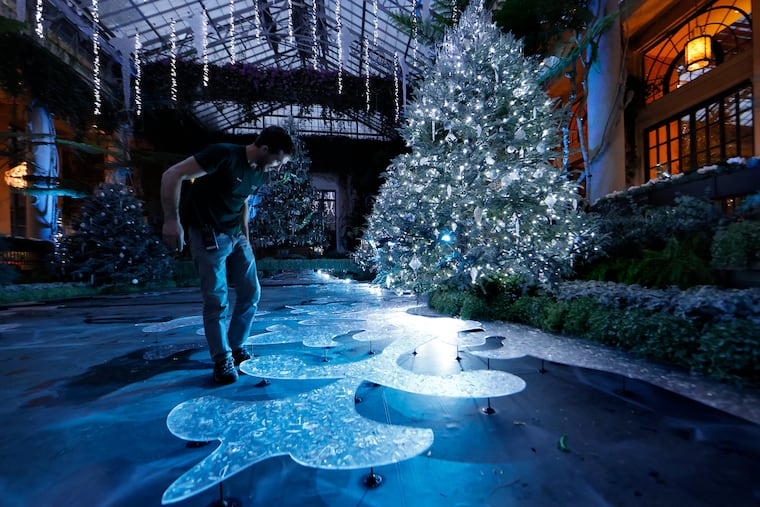Inside Longwood Gardens’ holiday light show, with 40 miles of wiring and 500,000 LED bulbs
The Longwood light brigades, involving up to 300 employees, have been at it since mid-August.

If they were stretched end to end, the wires bearing the bulbs for Longwood Gardens’ annual holiday light show would extend from the Longwood entrance on Route 1 in Kennett Square to the Benjamin Franklin Bridge.
And converting all 40 miles of that wire and those 500,000 LED bulbs into a starring role in one of the region’s most popular tourist attractions is a bit more complicated than, say, hanging icicle lights on the eaves of a split level.
The Longwood light brigades, involving up to 300 employees, have been at it since mid-August, Troy Sellers, the Gardens’ outdoor landscape manager, said Thursday as workers put the finishing touches on this year’s show, in advance of Friday’s grand opening.
» READ MORE: 2021 Philadelphia holiday events calendar
Given the history of the public response, it evidently will have been worth the trouble. The Longwood Christmas light show, now in its 49th year, draws up to 450,000 visitors annually, said spokesperson Trish Evans, with 58% of those being nonmembers. The rest of the year, fewer than 40% of visitors are nonmembers.
At $30 for an adult ticket — less for seniors and children — that would be several million dollars in nonmember admissions alone, not to mention being an enticement for memberships, along with food, beverage, and gift-shop sales.
This year’s theme is “Fire and Ice,” and it includes a light assortment that Evans describes as “lots of fiery red and ambers to cool blues and icy whites.”
Among the highlights are a decorated 90-foot hickory in the meadow; a 200-foot tunnel of light; outdoor fountain show; the model railway; and the lushly decorated conservatory, which also happens to house a phalanx of nationally recognized restrooms.
Through the years the light shows have become more elaborate and ambitious, and Sellers says that’s due in part to advances in technology — “We can make Christmas lights do amazing things” — and improvements by LED bulb manufacturers.
» READ MORE: Green smackdown: Lincoln Financial Field vs. U.S. Bank Stadium
“They can make a lot of more colors,” he said. “Colors have got truer.” They also are more environmentally friendly, according to the U.S. Department of Energy, consuming 80% less energy than their traditional counterparts and lasting 25 times as long.
The Longwood holiday light extravaganza is not only a regional tradition, it draws visitors from all over the world. And while dark-sky advocates may weep, NASA satellites have documented that what is happening at Longwood is part of an international movement, as outdoor decorative lighting for the holidays has grown immensely in popularity, particularly in suburban areas.
How it all started
Longwood began its Christmas tradition in 1957 with a display in the conservatory and added lights five years later, following a tradition modestly started by one Thomas Alva Edison.
During the 1880 Christmas season, the inventor had strung lights outside his Menlo Park, N.J., lab, and two years later his friend and business partner, Edward Johnson, became the first to decorate an evergreen with lights, according to a Library of Congress history.
» READ MORE: Christmas lights are going up early in this pandemic-darkened year as we look ‘for some joy’
The nation was slow to warm to electricity, but President Calvin Coolidge gave the holiday light tradition a mighty plug in 1923 when he fired up what was the first National Christmas Tree with 3,000 lights.
In recent years, of course, outdoor decorative lighting this time of year has proliferated exponentially. In 2014 NASA noted that satellites detected as much as a 50% increase in coverage in some areas during the six-week holiday period, compared with the rest of the year.
And it wasn’t just Christmas; lighting also amped up in the Middle East during Ramadan. NASA was asked to update the holiday light survey last year, but demurred, said Eleanor Stokes, with the NASA-affiliated Universities Space Research Association.
“People were saying because of COVID, everybody had more time to put out more lights,” said Stokes, now in charge of NASA’s remote light-sensing project. But, she said: “It’s not a high science priority for us.”
Lights out
By all appearances, holiday outdoor lighting has a bright future.
Stokes said NASA frequently is asked to be a “Grinch” regarding any environmental impacts of decorative outdoor lighting but that the agency has declined to do so. “I love decorating for Christmas. I’m neutral. I’m Switzerland.”
At Longwood, the crowds evidently have been drawn by the lights and have swollen over the years, Evans said, with people making reservations as early as August. By Thursday, 30% of the available reservations for the Nov. 19 to Jan. 9 period had been booked, she said.
She said so many people return year after year that Longwood tries to vary the themes, and Sellers said that is one of his biggest challenges.
For him, he said, when the lights went on Friday next year already had begun. “We start laying out next year’s display as soon as this one is installed,” he said.
The lights are on for 11 hours, from noon to 11 p.m., every day, Evans said, and they get a daily two-hour test run from 5 to 7 a.m.
Weekend days and the days between Christmas and New Year’s are the busiest periods, and Evans says if you’re open to showing up earlier in the day, you’ll have a better shot at a reservation.
The finale will be Jan. 9, and then the great put-away project begins. The lights are sorted by color and by year, said Sellers, because after six years, they tend to fade.
“Everybody has that neighbor who keeps light up year-round,” said Evans. “We don’t.”